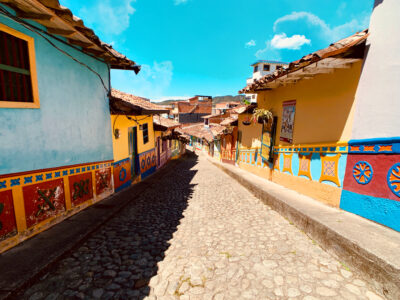
Durmitor National Park, Montenegro: The ultimate Wanderlust guide
The largely unexplored Durmitor National Park in Montenegro truly is one of the last remaining unspoiled wildernesses on the European continent. Here’s your guide to making the most of it…
An introduction to Durmitor National Park…

Bobotov Kuk, Durmitor’s highest peak (Shutterstock)
Mother nature spared no expense when gifting Durmitor with soaring limestone peaks, azure-blue canyons and serene glacial lakes (known locally as ‘mountain eyes’). They’re sprinkled generously across the 334 sq km UNESCO World Heritage Site.
Montenegro has its fair share of mountainous terrain. Durmitor National Park alone boasts a colossal 48 peaks – all over 2,000m high, with the highest, Bobotov Kuk, reaching 2,523m.

The Black Lake in Durmitor National Park, Montenegro (Shutterstock)
The park is home to 18 glacial lakes and five canyons, with the Tara River crowned the deepest canyon in Europe and one of the deepest in the world at 82km long and 1,300m deep.
Stumbling upon a secret this spectacular is a real game changer for lovers of nature, hiking, photography, skiing and activity breaks at pocket-friendly prices.
Getting to Durmitor National Park

Žabljak is close to Durmitor National Park, Montenegro (Shutterstock)
The good news is that whichever route you take to Durmitor National Park is guaranteed to deliver captivating views.
Žabljak is where many travellers choose to stay in Durmitor for both summer and ski seasons. The only way to get there is by road, so hiring your own car is the fastest and most reliable option.
Roads are well maintained but mountainous, so allow extra travel time and watch out for sharp bends, steep drops, overtaking adrenaline junkies and the occasional flock of sheep.

Podgorica, Montenegro’s capital (Shutterstock)
If travelling from Tivat, Žabljak is an easy three-hour drive heading West via the spectacular bay of Kotor.
Prepare to stop for photographs as you ascend the mountainous roads. You’ll be served breathtaking views of green mountain peaks rising majestically from the tranquil bay. Travellers from Croatia will take an almost identical route.
If travelling from Podgorica – the country’s capital – the journey takes around two hours via Ostrog Monastery in Danilovgrad, which is well worth a visit.

Ostrog Monastery, Montenegro (Shutterstock)

Nikšić, Montenengro (Shutterstock)
The best time to visit Durmitor National Park

Crno Jezero (the Black Lake) in spring, Durmitor National Park, Montenegro (Shutterstock)
The most popular time to visit Durmitor National Park is between May and October when the weather is good, all hiking routes are open and the park brims with activity.
These summer months offer canoeing, jeep tours, white water rafting, horseriding, cycling, paragliding, zip lining and more. Most of the glacial lakes in Durmitor National Park are ideal for swimming between July and September.
The largest and most popular is Crno Jezero – or the Black Lake – which is a leisurely 40-minute walk from the centre of Žabljak. A cafe next to the lake offers welcome respite for hikers and swimmers.

Snowy remains in Durmitor National Park, Montenegro (Shutterstock)
March and April are also great months to visit. The mountains are still snow capped, and crisp, sunny days make for ideal walking conditions.
As this is technically in-between seasons, not all activities are available and the park is very serene as a result. It’s an ideal time for landscape and wildlife photographers.
White water rafting is available pretty much all year round, with spring months offering a pacier experience in contrast to calm summer waters. The views alone make this activity worthwhile. Expect to pay around €45.
From December to March, Durmitor transforms into a ski resort, largely frequented by savvy Serbs and Bosnians seeking ski holidays at a fraction of the cost demanded by better-known Alpine countries.
Walking and hiking in Durmitor National Park

The Ice Cave in Durmitor National Park, Montenegro (Shutterstock)
There are a huge number of well-marked walking trails in Durmitor, but the most popular and accessible walking routes begin and end at the Black Lake.
In peak season, walkers and hikers are able to access most peaks and lakes from the Black Lake trail. One of the most difficult is the Ice Cave, taking approximately four to five hours.
For non-professional hikers, locals recommend Jablan Lake and Crvena Greda (Red Rock) – which also takes around four or five hours to hike.

Savin Kuk, a ski resort in Durmitor National Park, Montenegro (Shutterstock)
‘Lokvice Katun is approximately two hours from the Black Lake and from there, a lot of the better known peaks are reachable.
Bobotov Kuk – the highest peak in Durmitor National Park – is recommended for experienced climbers only. This trail is a 10-hour round trip from Žabljak.
For a slightly shorter (but full day) hike, try Planinica: an eight-hour round trip from Žabljak, with some of the best views across the entire park. Savin Kuk, Durmitor’s main ski resort, takes six hours (unless you cheat and take a ski-lift to the top).
Hiking is available with or without a guide but before you set off to climb any peaks, be sure to seek advice from your hotel on weather conditions, use a walking map (often not readily available, so bring your own) and carry appropriate hiking gear.

The viewpoint from Mount Ćurevac is a short hike away (Shutterstock)
Nature and wildlife in Durmitor National Park

A jay on the Black Lake, Durmitor National Park, Montenegro (Shutterstock)
This UNESCO protected paradise is covered by 1,325 species of flora – many of which can only be found in Durmitor. It’s also home to around 163 bird species, most of which are protected.
If you’re lucky (or perhaps unlucky) you may bump into brown bears, grey wolves, and European wildcats that roam the National Park. Wolves are more commonly sighted as they come down from the mountains to steal away livestock, so keep your eyes and ears peeled.
Chasing waterfalls in Durmitor

Tara Canyon underpass, Durmitor National Park, Montenegro (Shutterstock)

Tara Canyon waterfall, Durmitor National Park, Montenegro (Shutterstock)
The Tara Canyon is home to countless waterfalls, some of which spend days underground travelling 30km or more, before bursting out of the rocks at around 500 litres per second.
The best time to watch the waterfalls is during early spring and post heavy rain, although the turquoise waters are clearer when it hasn’t been raining.
To catch a glimpse of some of the most beautiful waterfalls, take a rafting tour to Šćepan Polje, which is where the River Drina forms the border between Montenegro and Bosnia & Herzegovina.


















